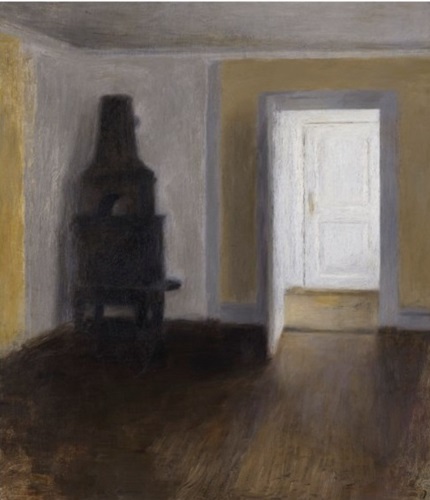
Vilhelm Hammershøi
Danish, 1864-1916
The White Door (Interior with an Old Jamb Stove), 1888
oil on unlined canvas
24 5/8 × 21 1/2 in.
SBMA, Museum purchase in honor of Larry J. Feinberg, SBMA Director, 2008-2023
2023.50

Vilhelm Hammershøi - Self-portrait, 1895, oil on canvas
“What makes me choose a motif is as much the lines in it, what I would call the architectural stance in the picture. And then the light, of course. It is naturally also very important, but the lines are almost what I am most taken by.” - Vilhelm Hammershøi
COMMENTS
SANTA BARBARA, CA.- The Santa Barbara Museum of Art (SBMA) announced the acquisition of one of the most significant 19th-century paintings in its history. Acquired from Agnews, London, the painting is the first interior created by Vilhelm Hammershøi (1864–1916) that is entirely devoid of people—a poetic vehicle for his nuanced psychological portraits of the experience of domestic spaces that still resonate today. Dubbed “the Danish Painter of Solitude and Light” by the breakthrough 1998 retrospective organized by the always prescient art historian Robert Rosenblum, the artist’s hauntingly melancholic, nearly monochromatic interiors have caused some to dub him “the Danish Vermeer.”
The painting was acquired in honor of the tenure of recently retired Director, Larry Feinberg. In response to news of this acquisition, Feinberg commented: “I am absolutely delighted that the Museum has acquired this beautiful and very important painting in my honor. I have long studied and admired the works of 19th-century Symbolist artists, and Hammershøi is the greatest of the Danish Symbolists. This is among the most significant acquisitions of 19th-century art that the Museum has made in decades.”
While the artist’s enigmatic depictions of solitary figures in anonymous empty rooms have been compared to the work of the American 20th-century figure painter, Edward Hopper, Hammershøi’s art was very much of its generation. He is typically thought of as a participant in international Symbolism, though he himself never identified with any specific school or movement. Symbolism was a European art movement that emerged between the two world wars, characterized by a fascination with interior psychological states and the dark side of humanity. Hammershøi’s early penchant for allegorical compositions that feel heavy with nostalgia for a pre-modern age have much in common with those of the French Symbolist, Puvis de Chavannes, for example, or the Swiss Symbolist, Ferdinand Hodler. But it was for his domestic interiors that Hammershøi earned the most critical accolades. This painting is the very first such interior that he did, completely devoid of people. Its striking modernity belies its early date of 1888. As the artist put it: “I have always thought there was such beauty about a room like that, even though there are no people in it, perhaps precisely because there are no people in it …”
The silence associated with Vermeer’s serene interiors becomes even more pervasive in Hammershøi’s early 20th-century renditions, which reverberate with unstated longing for a tranquility, then quickly vanishing in an industrial age. Like Edouard Vuillard, the French “intimiste,” Hammershøi took inspiration from the domestic environment around him. He used his mother, brother, and, most frequently, his wife Ida as models (and increasingly, photographs of them staged by him), though their relationship to him is not an essential aspect of the paintings’ significance. Rather, they are universal stand-ins for embodied existence, in which vision provides material access, but is psychologically repelled by the figures’ obliviousness to us.
In this painting, the subject remains ambiguous. The period rooms are emptied of the trace of everyday living, save for an imposing, old-fashioned jamb stove, of a kind made popular starting in the 18th century. Its abandonment underscores the absence of the sound of social interaction that the stove attracted in Victorian parlors, and the open door at center leads to another door, this time closed, as if to frustrate our desire to enter the space. The substance of the paint, applied with slow drags of the brush, somehow materializes space as defined by the sunlight streaming into the hallway and through the open door through an unseen window. Its complex, painterly surface, like so many great paintings of the recent past, eludes digital reproduction. As the poet and great admirer of Hammershøi, Rainer Maria Rilke once observed, “Hammershøi is not one of those about whom one must speak quickly. His work is long and slow, and at whichever moment one apprehends it, it will offer plentiful reasons to speak of what is important and essential in art.”
https://artdaily.com/news/165153/Santa-Barbara-Museum-of-Art-acquires-masterpiece-by-Danish-modernist
Ever since the major retrospective given to the artist in 1998 at the Guggenheim Museum in New York, Hammershøi has risen steadily in critical esteem and popular appeal. His manner of painting remained relatively consistent throughout his thirty-year career as “the Danish Painter of Solitude and Light,” per the title chosen for the 1998 exhibition. That project, which was co-organized by the always prescient Robert Rosenblem, along with Anne-Birgitte Fonsmark (director of the Ordrupgaard Museum, Copenhagen) and Henri Loyrette, (then Director of the Musée d’Orsay) was the sleeper hit of the season, as throngs of people marveled at this rediscovered master of the turn of the last century. Many commented that his hauntingly poetic, monochromatic interiors made him the “Danish Vermeer.”
However, like the most significant and original artists of his generation (Vincent van Gogh, who was around a decade older, springs to mind), Hammershøi was perceived in his lifetime as a natural fit with the prevailing aesthetics of international Symbolism. Although he himself never identified with any single avant-garde group, his appreciation and awareness of other artists often categorized as part of this movement becomes evident, once we recognize their shared sensibilities.
…it was the more modestly scaled interiors of a type practiced for centuries in the low countries, that cemented the artist’s reputation. In fact, our painting is recollected by the artist as the very first interior scene he did, completely devoid of people. He described it thus in an interview published in 1907: “The first interior I painted, if my memory doesn’t fail me, was out at Karl Madsen’s place. I stayed with him in the autumn of ’88 in an old house called Albertine Lyst. In any case, it was the first picture of an empty room I painted. I have always thought there was such beauty about a room like that, even though there are no people in it, perhaps precisely because there are no people in it” …
- Poul Vad, Vilhelm Hammershøi – Vӕrk og liv, Copenhagen, 1988, p. 62, 401
Karl Madsen was then an aspiring art critic, who would go on to become the director of the Statens Museum fur Kunst in Copenhagen and one of the artist’s most enthusiastic supporters. The significance of our painting as the first to exhibit the hallmarks of the artist’s signature style is attested, not only by the fact that it was acquired by the artist’s most important collector, Alfred Bramsen, who owned fifty-seven of his works, but by the artist’s choice to exhibit it multiple times. The painting was included in a show of Scandinavian art organized by Sergei Diaghilev in St. Petersburg, Russia in 1897, as well as in a show held in Berlin in 1900 and in another, held in Copenhagen the following year.
Our painting exists in a second version, made by the artist shortly after its creation and now in the collection of the Statensmuseum fur Kunst, Copenhagen. (Vilhelm Hammershøi, Interior, the Old Stove, 1888, Statens Museum for Kunst, 60 x 52 cm.) The pinholes used by the painter to create a proportionate grid by which to replicate the composition are still in evidence at the corners of the stretched canvas of our painting. Comparison between the two shows an exact duplication of the composition in the second version, although Hammershøi chose to condense its elements by cropping it at the bottom and left side.
The silence associated with Vermeer’s serene interiors becomes even more pervasive in Hammershøi’s early 20th-century renditions, which resonate with unstated longing for a tranquil quietude then quickly vanishing in an industrial, modern age.
Eik Kahng, SBMA Collections Committee Report, December 5, 2023
SBMA CURATORIAL LABELS
This important painting has just been acquired in honor of our recently retired director, Larry Feinberg.
The critical reputation of the singular Danish modernist Hamrnershøi has steadily risen since the breakthrough 1998 retrospective, organized by the Guggenheim Museum in New York. Known as "the Danish Painter of Solitude and Light,” Hammershøi's hauntingly poetic, monochromatic interiors have caused some to dub him the “Danish Vermeer." It was for his domestic interiors that Hammershøi earned the most critical accolades. Our painting is the very first such interior that he did, completely devoid of people.
Hammershøi’s interiors resonate with unstated longing for a tranquility then quickly vanishing in an industrial, modem age. In this painting, the subject remains ambiguous. The period rooms are emptied of the trace of everyday living, save for an imposing, old-fashioned jamb stove, of a kind made popular starting in the 18th century. Its abandonment underscores the absence of the sound of social interaction that the jamb stove attracted in the Victorian parlors that it warmed and the open door at center leads to another door, this time closed, as if to further frustrate our desire to enter the space. The substance of the paint, applied with slow drags of the brush, somehow materializes space as defined by the sunlight streaming into the hallway and through the open door through an unseen window. As the poet and great admirer of Hammershøi, Rainer Maria Rilke once observed, “Hammershøi is not one of those about whom one must speak quickly. His work is long and slow, and at whichever moment one apprehends it, it will offer plentiful reasons to speak of what is important and essential in art.“
- Ridley-Tree Gallery, 2023
